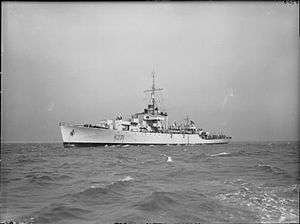HMS Plym (K271)
 | |
| History | |
|---|---|
| Name: | HMS Plym |
| Namesake: | River Plym |
| Builder: | Smiths Dock Co., South Bank-on-Tees |
| Laid down: | 1 August 1942 |
| Launched: | 4 February 1943 |
| Commissioned: | 16 May 1943 |
| Decommissioned: | 1952 |
| Fate: | Destroyed on 3 October 1952 in the Operation Hurricane nuclear bomb test in the Montebello Islands, Western Australia. |
| General characteristics | |
| Class and type: | River class frigate |
| Displacement: |
|
| Length: | |
| Beam: | 36.5 ft (11.13 m) |
| Draught: | 9 ft (2.74 m); 13 ft (3.96 m) (deep load) |
| Propulsion: | 2 x Admiralty 3-drum boilers, 2 shafts, reciprocating vertical triple expansion, 5,500 ihp |
| Speed: | 20 knots (37.0 km/h) |
| Range: | 646 long tons (656 t) oil fuel; 7,500 nautical miles (13,890 km) at 15 knots (27.8 km/h) |
| Complement: | 140 |
| Armament: |
|
| Notes: | Pennant number K271 |
HMS Plym (K271) was a River class frigate that served in the Royal Navy between 1943 and 1952.
Construction
Plym was built to the Royal Navy's specifications as a Group II River class frigate. She was laid down at Smiths Dock Co., South Bank-on-Tees on 1 August 1942 and launched on 4 February 1943.
She was commissioned into the RN on 16 May 1943 as HMS Plym (K271) and was named after the River Plym in Devon, England which flows into the English Channel at Plymouth.
War service
Plym saw extensive service on Atlantic convoy escort missions.
Plym, along with HMS Bann, HMS Teviot and HMS Trent, provided anti-submarine escort to the convoy WS-33 which arrived in South Africa from the United Kingdom on 9 October 1943 with critical reinforcements for service in Burma.
Operation Hurricane
Plym was used as the detonation platform for the UK's first nuclear weapon in Operation Hurricane. A 25 kiloton atom bomb was detonated a few seconds before 09:30 local time on 3 October 1952 approximately 400 metres from the island of Trimouille in the Monte Bello Islands, Western Australia.
Although data acquisition would have been simplified by detonating the bomb from a tower above the ground or sea surface, it was conducted aboard the Plym in order to simulate the effects of a nuclear weapon being smuggled into a British harbour aboard a ship, which was considered a real possibility at the time.
References
- Colledge, J. J.; Warlow, Ben (2006) [1969]. Ships of the Royal Navy: The Complete Record of all Fighting Ships of the Royal Navy (Rev. ed.). London: Chatham Publishing. ISBN 978-1-86176-281-8. OCLC 67375475.